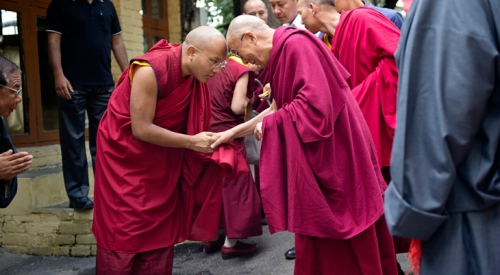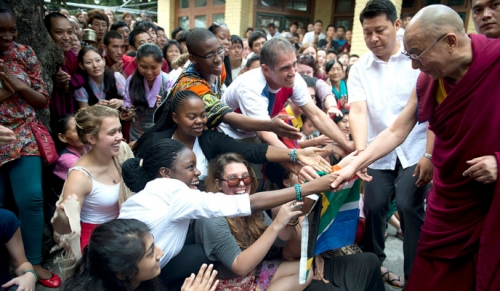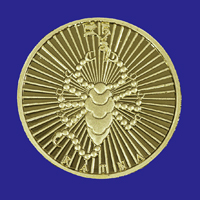Happy birthday to the Dalai Lama! His Holiness turns 77 today. Here he is greeting Ogyen Trinley Dorje, one of the two claimants to the Karmapa’s throne, at his birthday party in Dharamsala.

And here he is again with some excited birthday revelers.

You can see more photographs of the festivities on his official website.
 Earlier this week the Shambhala community was celebrating as well, albeit for a different reason. For the first time since 1991, Shambhala is minting its currency, the ratna. The ratna was first produced in 1983 under the guidance of Chogyam Trungpa Rinpoche. These days Sakyong Mipham Rinpoche, Trungpa’s son, is heading the production, but the general look of the coins remains the same: the profile of the current Sakyong, encircled by the words “Profound, Brilliant, Just, Powerful, All-Victorious” on one side and the Sakyong scorpion seal on the other.
Earlier this week the Shambhala community was celebrating as well, albeit for a different reason. For the first time since 1991, Shambhala is minting its currency, the ratna. The ratna was first produced in 1983 under the guidance of Chogyam Trungpa Rinpoche. These days Sakyong Mipham Rinpoche, Trungpa’s son, is heading the production, but the general look of the coins remains the same: the profile of the current Sakyong, encircled by the words “Profound, Brilliant, Just, Powerful, All-Victorious” on one side and the Sakyong scorpion seal on the other.
I don’t think a ratna will buy you much, but it will cost you to obtain one. The gold ratnas are $2500 a pop; the silver ones, $80.
Keeping in line with this photo-heavy Buddha Buzz, I’d like to introduce you to the work of Tou Chih-kang (professionally known as Tou Yun-fei). Tou captures abandoned dogs in their last moments—after he takes their picture, “veterinary workers take them for a brief turn around a grassy courtyard before leading them into a small, clinical-looking room where they are killed by lethal injection.” These Taiwanese dogs, most of whom have been turned out by their owners, receive a 12 day grace period after abandonment during which shelter workers and government authorities try to find them a new home. If they can’t find one in less than two weeks, the dogs are killed.
Tassanee Vejpongsa explains in an Associated Press article about Tou,
This year Taiwanese authorities will euthanize an estimated 80,000 stray dogs. Animal-welfare advocates say the relatively widespread nature of the phenomenon—Taiwan’s human population is only 23 million—reflects the still immature nature of the island’s dog-owning culture and the belief among some of its majority Buddhist population that dogs are reincarnated humans who behaved badly in a previous life.
You’ll see in the photos below that Tou often poses the dogs so that they are sitting formally, like humans. This is because he wishes to echo an old portrait style that “bestow[s] dignity and prestige upon the subject.”
This is bodhisattva work, for sure.
Images: The Dalai Lama at his birthday festivities. From www.dalailama.com
Ratna image from www.shambhalatimes.org.
See more of Tou Chih-kang’s work here.